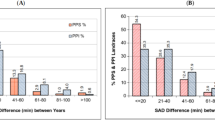Summary
Three similar field experiments with five cultivars were carried out to evaluate the effect of a 5-hour extension of the natural daylength and a 3-hour night break on flowering and TPS production in the warm tropics. Shoot length, number of inflorescence positions per plant and number of flowers per inflorescence varied considerably between the experiments. In each experiment, the supplementary photoperiods delayed cessation of shoot growth and thereby increased the orders of branching and the number of inflorescence positions per plant. The photoperiod treatments significantly increased the number of flowers at the last produced inflorescence positions, but not at other ones. Pollen production and quality, berry set, seed set and 100-seed weight were not affected by the photoperiod treatments. TPS production was characterized by variability in flowering and low and variable seed production per flower.
Similar content being viewed by others
References
Almekinders, C.J.M. & S.G. Wiersema, 1991. Flowering and true seed production in potato (Solanum tuberosum L.). 1. Effects of inflorescence position, nitrogen treatment, and harvest date of berries.Potato Research 34: 365–377.
Belling, J., 1921. On counting chromosomes in pollen mother cells.American Nature 55: 573–574.
Bodlaender, K.B.A., 1963. Influence of temperature, radiation and photoperiod on development and yield. In: J.D. Ivins & F.L. Milthorpe (Eds), The growth of the potato. Butterworth, London, pp. 199–210.
Burton, W.G., 1989. The potato. Third edition. Longman, Essex.
Clarke, A.E. & P.M. Lombard, 1939. Relation of length of day to flower and seed production in potato varieties.American Potato Journal 16: 236–244.
Clarke, A.E. & P.M. Lombard, 1942. Flower bud formation in the potato plant as influenced by variety, the size of seed piece and light.American Potato Journal 19: 97–105.
Demagante, A.L. & P. Vander Zaag, 1988. The response of potato (Solanum spp.) to photoperiod and light intensity under high temperatures.Potato Research 31: 73–83.
De Zeeuw, D., 1954. De invloed van het blad op de groei.Mededelingen Landbouw Hogeschool, Wageningen 54: 1–44.
Ewing, E.E., 1981. Heat stress and the tuberization stimulus.American Potato Journal 58: 31–49.
Ewing, E.E. & P.C. Struik. Tuber formation in potato: induction, initiation and growth.Horticultural Reviews (in press).
Horton, D. & R.L. Sawyer, 1985. The potato as a world-food crop. In: P.H. Li (Ed.), Potato Physiology. Academic Press, New York, pp. 2–34.
Jones, H.A. & H.A. Borthwick, 1938. Influence of photoperiod and other factors on the formation of flower primordia in the potato.American Potato Journal 15: 331–336.
Kinet, J.M., 1977. Effect of light condition on the development of the inflorescence in tomato.Scientia Horticulturae 6: 15–26.
Kuo, C.G., B.W. Chen, M.H. Chou, C.L. Tsai & T.S. Tsay. 1978. Tomato fruitset at high temperatures. Proceedings of the 1st International Symposium on Tropical Tomato, October 23–27, 1978, Taiwan.
Malagamba, P., 1988. Potato production from true seed.HortScience 23(3): 495–500.
Marinus, J. & K.B.A. Bodlaender, 1975. Response of some potato varieties to temperature.Potato Research 18: 189–204.
Mortenson, L.R., S.J. Peloquin & R.W. Hougas, 1964. Germination ofSolanum pollen on artificial media.American Potato Journal 41: 322–328.
Pallais, N., N. Fong & D. Berrios, 1985. Research on the physiology of potato sexual seed production. In: Innovative methods for propagation of potatoes. CIP, Lima, Peru, pp. 149–168.
Snyder, R.G. & E.E. Ewing, 1989. Interactive effects of temperature, photoperiod, and cultivar on tuberization of potato cuttings.HortScience 24(2): 336–338.
Turner, A.D. & E.E. Ewing, 1988. Effects of photoperiod, night temperature, and irradiance on flower production in the potato.Potato Research 31: 257–268.
Umaerus, M., 1987. True potato seed. In: Proceedings of the 10th triennial conference of the European Association for Potato Research. Aalborg, Denmark, 1987, pp. 72–102.
Upadhya, M.D., K.C. Thakur, Asha Juneja & M.S. Kadian, 1985. True potato seed production: flowering, quality and economics. In: Innovative methods for propagation of potatoes, CIP, Lima, Peru, pp. 117–147.
Werner, H.O., 1942. Relation of length of photoperiod and intensity of supplemental light to the production of flowers and berries in the greenhouse by several varieties of potatoes.Journal of Agricultural Research 64: 257–275.
Author information
Authors and Affiliations
Rights and permissions
About this article
Cite this article
Almekinders, C.J.M. The effect of photoperiod on flowering and TPS production in the warm tropics. Potato Res 35, 433–442 (1992). https://doi.org/10.1007/BF02357599
Accepted:
Issue Date:
DOI: https://doi.org/10.1007/BF02357599




